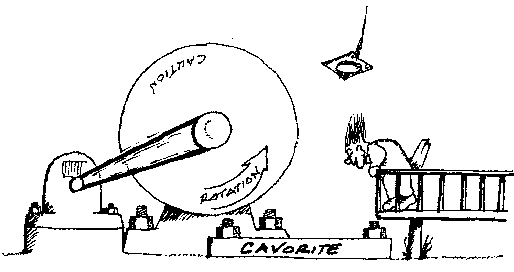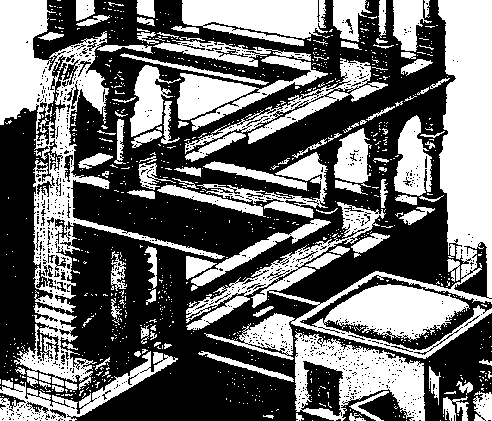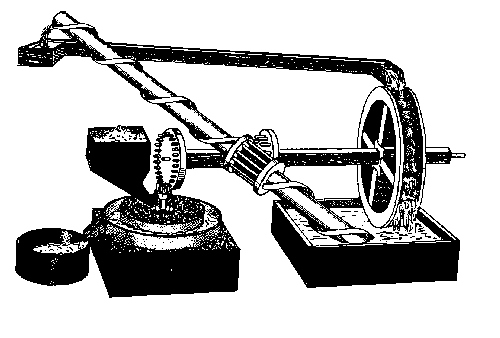What is Perpetual Motion?
Possibly Free energy devices?
The general public sees perpetual motion inexactly. Probably they view each machine as a special case. The physicist or engineer, on the other hand, is very precise and classifies perpetual motion machines according to which law of thermodynamics they violate. I'll reach this classification scheme presently, but here are some ways to classify perpetual motion machines which are motivated by reading Ord-Hume1 and Angrist2.- Magical devices. Our first category is of machines
that aren't real, but which get classified as perpetual motion anyway.
These operate by no known principle. For example, the self accelerating
wheel that has one side shielded with the H.G. Wells material "Cavorite"
as in Figure 1.
 Figure 1. Our academic grips the guardrail to view the
cavorite engine, but losses his mortar board. Notice the large bolts
that are required to keep antigravity material attached to the earth.
Figure 1. Our academic grips the guardrail to view the
cavorite engine, but losses his mortar board. Notice the large bolts
that are required to keep antigravity material attached to the earth.
- Impossible machines. Our second category is of machines
that defy logic; like the drawings of Maurice Escher, where water runs
perpetually down hill, but in a closed cycle. In fact, Escher did make
one drawing of a waterwheel run perpetually in such a flow (See Figure
2). Another impossible machine has weights of magnitude "9" on one side
which become of weight "6" on the other when the weights turn
upside-down.
 Figure 2. A small section of an Escher woodcut showing
water flowing in an endless circuit. Drawings like these are often
called 'ambiguous.'
Figure 2. A small section of an Escher woodcut showing
water flowing in an endless circuit. Drawings like these are often
called 'ambiguous.'
- The next category are real machines, but people often lump them, and perhaps confuse them, with true perpetual motion machines. For instance, a Rube Goldberg machine is simply difficult to analyze and obscure of purpose. Maybe it is intended to work forever, maybe not, but it looks complicated so the typical person thinks it's probably a perpetual motion machine. Into this class also goes any harebrained inventor's scheme.
- A real machine might be viewed as perpetual motion if it simply runs for a long time. Radioactive decay and rotation of the earth are examples. These actually run down slowly, so they aren't truly perpetual motion machines. They are perpetual only in the sense that they outlast a person's life or memory. (See technical notes.)
- Foremost among machines intended to deliver perpetual motion are the frauds. These typically are any overly complicated machine running, ostensibly forever, in a completely mysterious cycle of operation with hidden workings (and hidden source of energy). Hiding portions of the workings ostensibly avoids disclosing "proprietary" knowledge about the machine, but also avoids disclosing the inventor as a fake. Examples are the Keely motor (late 1800s) and the machine of E.P. Willis (1850). Keely once suggested that he was "Keely, greatest humbug of the nineteenth century."
- A large class of schemes are machines that are perpetually out of balance,
so that a push start will make the machine run forever, or perhaps even
cause it to accelerate. These machines typically remain only in a
design stage. If built they may become machines of type 5 above,
especially after the disappointed inventor realizes his need to recover
expenses. Villard de Honnescourt drew designs for such machines. Seven
centuries later and more than one century beyond an understanding of why
such a machine will never work, inventors continue to attempt to make
the unbalanced wheel spin.
 Figure 3. Drawing of a wheel that is eternally out of
balance. It is sometimes very difficult to explain the mechanical fault
that keeps these machines from running. It is much easier to attack
their violations of the first law of thermodynamics.
Figure 3. Drawing of a wheel that is eternally out of
balance. It is sometimes very difficult to explain the mechanical fault
that keeps these machines from running. It is much easier to attack
their violations of the first law of thermodynamics.
An elderly Minnesota farmer 3, made the most recent attempt to build an out-of-balance machine that I know of. He had been working for 20 years on a large iron wheel surrounded by a dozen bicycle wheels, complete with springs to continually move the bicycle wheels toward or away from the main axle.
As of 1973, his wheel hadn't managed more than 12 revolutions before grinding to a halt. Undeterred, however, our Minnesotan presses on.
" ...its equipment shortage what's tying me up right right now," he says. "I ordered them inner tubes weeks ago and haven't got them yet. But, I think they could be it." - Machines based on a misunderstanding of a measurement.
In these machines the inventor calculates perpetual motion, he does not
actually observe it. An example is the motor of Garabed Giragossian who
confused energy with power. The essense of his machine was putting
energy into the machine for a long time at low power, and withdrawing
the energy for a short period at high power. He managed to convince
himself, along with some majority of Congress, that having more peak
output power than peak input power is the same thing as obtaining extra
energy. What matters is energy. Using peak power as a proxy for energy
managed only to confuse everyone, including the inventor.
Cold fusion, while not a perpetual motion machine, is another example of misleading measurement. Fleischman and Pons calculated a very small excess of energy after making huge corrections to their data, and concluded that this must be derived from fusion even though more plausible explanations were available. - Machines without losses or friction are common designs.
One is Fludd's closed cycle water pump which raised water into a
reservoir by means of a Achimedean screw, and let water run out of the
reservoir over a water wheel that turned the screw to raise the water
(Figure 4). In order for this machine to run forever, we have to assume
that the grinding of grain represents no loss, nor is there any loss to
friction. In 1570 a Jesuit Priest, Johannes Taisnierus, designed a
machine based on a loadstone, which would pull an iron marble up an
incline where it would fall though a hole, roll down a second incline
back to its point of origin to begin the trek up the first incline. This
machine I discuss in a later section since it appears again and again
in articles on perpetual motion. These machine somehow procure energy to
offset losses, but there is no source of energy.
 Figure 4. The perpetual watermill of Fludd. This
machine violates the first law of thermodynamics. In reality it could
only operate until its initial supply of energy, which it obtained from
the lacky who filled the upper reservoir, is exhausted.
Figure 4. The perpetual watermill of Fludd. This
machine violates the first law of thermodynamics. In reality it could
only operate until its initial supply of energy, which it obtained from
the lacky who filled the upper reservoir, is exhausted.
- A more subtle class of machines do not obtain energy from
nowhere, nor do they leave out friction. They are impossible
nonetheless. These machines withdraw heat from a reservoir, perform
work, and change nothing else in the universe. They have a closed cycle
of operation that brings all parts back to an original state. Proposals
for this sort of machine were common before people understood what we
now call the second law of thermodynamics. John Gamgee's ammonia motor
is an example.
Gamgee envisaged a motor to propel ships using ammonia as the working fluid. Liquid ammonia boils at a low temperature--well below the temperature of sea water, for instance. Gamgee proposed a liquid ammonia boiler to absorb heat from sea water near temperatures as low as 0°C. At this temperature its vapor expands 4 times until its pressure drops to equal that of the atmosphere. All the while it moves a piston which can turn a ship's propeller. In Gamgee's thinking the ammonia has now expanded so much, and done so much work, that it is cold, and condenses to liquid to begin the cycle over again.
What Gamgee, and his backers, didn't realize is that the expanded ammonia is cold, but not cold enough to condense. It must expel some additional heat to a colder reservoir to cool further. But no colder reservoir is available, and no condensation ever occurs. The machine never completes more than half a cycle. - Perpetual lamps. Here the machine is actually a process
(combustion). Fortunio Liceti (1577-1657) made a lifelong study of these
lamps, so many of which were supposedly found in old tombs, vaults and
temples. Ord-Hume spends several pages examining ways to explain the
observation of perpetual lamps. This is giving too much serious
attention to a fantasy. It is likely that no one ever observed any such
lamp. They belong to the realm of myth like the unicorns and half-man
beasts.
I have found a graphic of a perpetual lamp at an exotic site on the web. You may go to visit it by clicking on the eternal flame. Please return though.
Perpetual Motion and Thermodynamics
Thermodynamics developed from the analysis of machines and processes. Physicists and mathematicians have made it a rigorous science, but its axioms derived from hundreds of years of experience.Physicists and engineers view perpetual motion precisely and abstractly. In fact, they view the idea of "machine" so abstractly that machines or processes or signals or even algorithms fit the definition. To them any machine violating one of the laws of thermodynamics is a perpetual motion machine. They classify a perpetual motion machine by which law it violates. So a machine violating the first law of thermodynamics is a perpetual motion machine of the first kind. Machines violating the second law of thermodynamics are perpetual motion machines of the second kind, and so forth.
There are very few ideas in physics important enough to call laws. The four laws of thermodynamics are especially important and useful. At one time I examined patents for an industrial company. The question I had to answer was..."will this process or that machine work? Should we buy this patent?" Most machines or processes are too complex to analyze directly in a short time. However, the laws of thermodynamics apply to their operation and make them much simpler to analyze. The analysis begins by abstracting the machine or process to its inputs, losses, and outputs. Then it is simple to apply the laws of thermodynamics to it; and if the machine violates one of the laws, we can send the patent back to the inventor with a polite thank you.
Perpetual motion machines are ordinarily of the first or second kind. However, there is a zeroth law of thermodynamics and also a third law. I know of no one who has written descriptions of perpetual motion machines of the zeroth and third kinds. What would these be like?


0 Comments::
Post a Comment
Hope you enjoyed :)